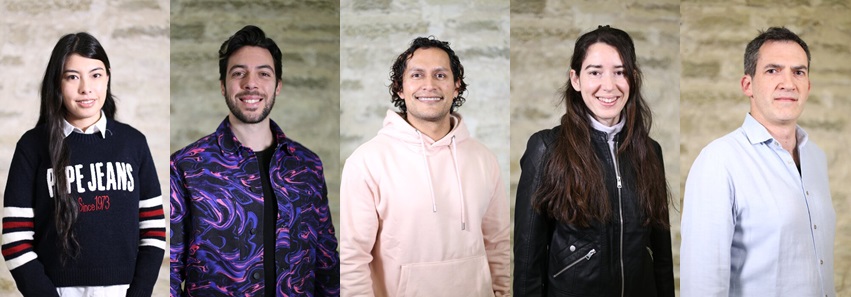The researchers from the Institute for Research, Development and Innovation in Health Biotechnology of Elche (IDiBE) Salomé Araujo Abad and Francisco Javier Álvarez Martínez have received first prizes and Julio Salazar, Eva María Villalba Riquelme and David Cabañero have been awarded second prizes of the announcement. The first prizes receive 2,500 euros, while the second prizes receive 1,500 euros.
The first two prizes, obtained by Salomé Araujo and Francisco Javier Álvarez, focus respectively on cancer and on the study of the antibacterial activity of natural compounds.

Salomé Araujo Abad’s work entitled “Biomedical Application of Small Extracellular Vesicles in Cancer Treatment” was published in the journal Advanced Drug Delivery Reviews. This is a literature review focused on extracellular vesicles (EVs), including exosomes, which represent promising biomarkers and therapeutic vehicles in diseases such as cancer. Among the aspects analyzed are their relevance, highlighting their content and their implication in different types of cancer, as well as the clinical tests approved by the FDA that use them. Chimeric EVs and their potential to transport nanoparticles and anticancer drugs are also explored, with a focus on specific treatments, and clinical studies are included that show the potential of EVs in cancer prognosis, offering hope in the fight against this pathology. The objective of the work was to understand and apply EVs in personalized medicine, since they can transform clinical practice and improve patient survival, highlighting their crucial role in the search for effective cancer treatments.

The bibliographic review “Antibacterial plant compounds, extracts and essential oils: An updated review on their effects and putative mechanisms of action”, published by Francisco Javier Álvarez Martínez in the journal Phytomedicine, focuses on studying antibiotic-resistant bacteria that represent a serious threat to global health. The effectiveness of traditional antibiotics is compromised, which has prompted the search for new effective antimicrobials. In this context, plants are emerging as an invaluable source of antimicrobial compounds with enormous therapeutic potential. This study reviews the antimicrobial activity of various compounds of plant origin, including phytochemicals, extracts and essential oils. Among the most relevant results, the activity of polyphenols and terpenes stands out, both individually and together within extracts or essential oils. However, new omics technologies and the application of network pharmacology are needed to optimize combinations between these compounds or with traditional antibiotics, and thus develop suitable antimicrobials to combat the growing threat of resistant bacteria.

On the other hand, among the second prizes, it is possible to cite the work of Julio Salazar, entitled “Potential of Persimmon Dietary Fiber Obtained from Byproducts as Antioxidant, Prebiotic and Modulating Agent of the Intestinal Epithelial Barrier Function”, published in the journal Antioxidants, which reveals how the processing of food byproducts, specifically persimmon fiber (Diospyros kaki Thunb.), impacts intestinal health benefits, including its digestibility, prebiotic and antioxidant action. The technique used releases gallic acid, a recognized antioxidant, and produces beneficial substances for epithelial cells, contributing to intestinal health. This study highlights the potential of persimmon polysaccharides as a valuable resource for nutrition and health, and has opened avenues for future research on how these components could be applied.

Likewise, the work of Eva María Villalba Riquelme published in the British Journal of Pharmacology and entitled “Paclitaxel in vitro reversibly sensitizes the excitability of IB4(-) and IB4(+) sensory neurons from male and female rats” was awarded, in which It was investigated how paclitaxel, a drug commonly used to treat cancer, is capable of activating the sensory neurons responsible for generating pain. Understanding paclitaxel-induced neuropathy is essential since this painful sensation can worsen to such an extent that treatment must be stopped or sedatives must be used. The work of Dr. Villalba and collaborators identifies molecular mechanisms that are altered after treatment with paclitaxel and that are responsible for the alteration of these neurons, such as the increase in the activity of the TRP and NaV channels. Furthermore, it was discovered that these mechanisms were differently altered depending on sex, which could explain the greater sensitivity of women to this chemotherapy treatment.

Finally, the work of researcher David Cabañero was also recognized, published in the prestigious journal Nature Communications (“TRPM8 contributes to sex dimorphism by promoting recovery of normal sensitivity in a mouse model of chronic migraine”) and who focused on understanding why Female sex is more prone to migraines than males. Using a mouse model of chronic migraine, a receptor called TRPM8, known for its role in feeling cool, was found to protect male mice from this type of pain. In fact, by eliminating TRPM8 in male mice, they became as sensitive to pain as female mice. Furthermore, by analyzing castrated animals and through in vitro cellular assays, the authors found that testosterone interacts with TRPM8 to exert its protective effect, independently of the androgen receptor. These findings suggest new possibilities for the development of migraine treatments tailored to the patient’s sex.
The director of IDiBE, Antonio Ferrer, wanted to point out that “the promotion of young talent is especially important in science and at our institute we are totally proud of the work carried out by our researchers and we are committed to supporting them in the development of their professional careers.”

